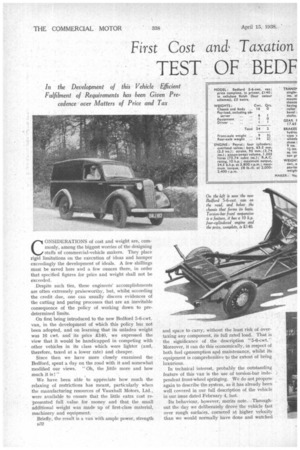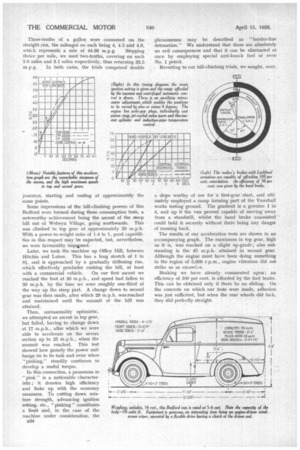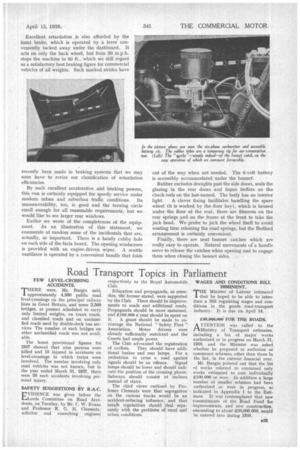First Cost and Taxation thjugation Proved Right in
Page 42

Page 43

Page 44

Page 45

If you've noticed an error in this article please click here to report it so we can fix it.
TEST OF BEDF UD 5-6-cwt. VAN
CONSIDERATIONS of cost and weight are, commonly, among the biggest worries of the designing staffs of commercial-vehicle makers. They place rigid limitations on the execution of ideas and hamper exceedingly the development of ideals. A few shillings must be saved here and a few ounces there, in order that specified figures for price and weight shall not be exceeded.
Despite such ties, these engineers' accomplishments are often extremely praiseworthy, but, whilst according the credit due, one can usually discern evidences of the cutting and paring processes that are an inevitable consequence of the policy of working down to predetermined limits.
On first being introduced to the new Bedford 5-0-cwt. van, in the development of which this policy has not been adopted, and on learning that its unladen weight was 16 cwt. and its price £140, we expressed the view that it would be handicapped in competing with other vehicles in its class which were lighter (and, therefore, taxed at a lower rate) and cheaper.
Since then we have more closely examined the Bedford, spent a day on the road with it and somewhat modified our views. "Oh, the ,little more and how much it is V' .
We have been able to appreciate how much the relaxing of restrictions has meant, particularly when the manufacturing resources of Vauxhall Motors, Ltd., were available to ensure that the little extra cost represented full value for money and that the small additional weight was made up of first-class material, machinery and equipment.
Briefly, the result is a van with ample power, strength tin and space to carry, without the least risk of overtaxing any component, its full rated load. That is the significance of the description "5-6-cwt." lVforeover, it can do this economically, in respect of both fuel cpnsurnption and maintenance, whilst its equipment is comprehensive to the extent of being luxurious.
In technical interest, probably the outstanding feature of this van is the use of torsion-bar inde pendent front-wheel springing. We do not propose again to describe the system, as it has already been well covered in our full description of the vehicle in our issue dated February 4, last.
Its behaviour, however, merits note. Throughout the day we deliberately drove the vehicle fast over rough surfaces, cornered at higher velocity than we would normally have done and watched the consequences of vigorous braking. The suspension struck us as exceptionally good, likewise the cornering, there being no sensation of insecurity, whilst better braking on a van of this weight we have yet to experience.
These qualifications are enhanced by the lightness of the steering and by the silence and freedom from vibration of the engine and transmission. Furthermore, the smooth clutch, the powerful but easily applied brakes and the synchromesh gearbox, which removes the need for skill or care in making changes, must certainly promote the driver's welfare.
In operating interest, fuel economy will presumably conic first. A number of steps has been taken to ensure low consumption, notably, the " six-phase" carburetter —which automatically switches from one mixture to another as conditions demand—the wide-gap plugs and centrifugal-vacuum ignition control.
We conducted two consumption tests, one a straight run and the other with three stops per mile. Incidentally, the latter was made mainly over narrow country lanes, with numerous twists and turns and rarely running level.
Those who know the north-eastern extremity of the Chiltern Hills, through which runs the border of Bedfordshire and Hertfordshire, just to the east of Luton, will appreciate that the conditions were not conducive to economical running. A somewhat easier route, but not without hills, was chosen for the non-stop test.
Accurate measurements were made possible by a Zenith test instrument, delivering tenths of a gallon, and the speedometer was checked and found to have the negligible error of 1 per cent.
Three-tenths of.. a gallon were consumed on the straight run, the mileages on each being 4, 4.5 and 4.9, which represents a rate of 44.66 m.p.g. Stopping thrice per mile, we used two-tenths, covering on each 3.6 miles and 3.1 miles respectively, thus returning 33.5 m.p.g. In both cases, the trials comprised double journeys, starting and ending at approximately the same points.
Some impressions of the hill-climbing powers of this Bedford were formed during these consumption tests, a noteworthy achievement being the ascent of the steep hill out of Welwyn Village, going southwards. This was climbed in top gear at approximately 20 m.p.h. With a power-to-weight ratio of 1.4 to 1, good capabilities in this respect may be expected,. but, nevertheless, we were favourably impressed.
Later, we took the marhine up Ofiley Hill, between Hitchin and Luton. This has a long stretch of 1 in 8, and is approached by a gradually stiffening rise, which effectively precludes rushing the hill, at least with a commercial vehicle. On our first ascent we reached the foot at '40 m.p.h., and speed had fallen to 30 m.p.h. by the time we were roughly one-third of the way up the steep part. A change down to second gear was then made, after which 29 m.p.h. was reached and maintained until the summit of the hill was attained.
Then, unreasonably optimistic, we attempted an ascent in top gear, but failed, having to change down at 17 m.p.h., after which we were able to accelerate on the severe section up to 25 m.p.h., when the summit was reached. This test showed how gamely the power unit hangs-On to its task and even when ." pinking," steadily continues to develop a useful torque.
In this connection, a proneness to " pink " is a noticeable-characteristic; it denotes high efficiency and links up with the economy measures. To cutting down mixture strength, advancing ignition setting, etc., "pinking" constitutes a limit and, in the case of the machine under consideration, the B34 phenomenon may be described as "border-line detonation." We understand that there are absolutely no evil consequences and that it can be eliminated at once by employing special anti-knock fuel or even No. 1 petrol.
Reverting to our hill-climbing trials, we sought, next, a slope worthy of use for a first-gear start, and ultimately employed a ramp forming part of the Vauxhall works testing ground. The gradient is a genuine 1 in 4, and up it the van proved capable of moving away from a standstill, whilst the band brake unassisted could hold it securely without there being any danger of running back.
The results of our acceleration tests are shown in an accompanying graph. The maximum in top gear. high as it is, was reached on a slight up-grade; also outstanding is the 45 m.p.h. attained in second gear. Although the engine must have been doing something in the region of 5,000 r.p.m., engine vibration did not strike us as excessive.
Braking we have already commented upon ; an efficiency of 100 per cent. is afforded by the foot brake. This can be obtained only if there be no sliding. On the concrete on which our tests were made, adhesion was just sufficient, but when the rear wheels did lock, they slid perfectly straight. Excellent retardation is also afforded by the hand brake, which is operated by a lever conveniently tucked away under the dashboard. It acts on only the back wheel, but from 30 m.p.h. stops the machine in 60 ft., which we still regard as a satisfactory best braking figure for commercial vehicles of all weights. Such marked strides have recently been made in braking systems that we may soon have to revise our classification of retardation efficiencies.
By such excellent accelerative and braking powers, this van is certainly equipped for speedy service under modern urban and suburban traffic conditions. Its manceuvrability, too, is good and the turning circle small enough for all reasonable requirements, but we would like to see larger rear windows.
Earlier we wrote of the completeness of the equipment. As an illustration of this statement, we enumerate at random some of the incidentals that are, actually, so important. There is a handy cubby hole on each side of the facia hoard. The opening windscreen is provided with an engine-driven wiper. A scuttle ventilator is operated by a convenient handle that folds out of the way when not needed. The 6-volt battery is accessibly accommodated under the bonnet.
Rubber excludes draughts past the side doors, seals the glazing in the rear doors and focins buffers on the check rods on the last-named. The body has an interior light. A clever fixing facilitates handling the spare wheel (it is worked by the door key), which is housed under the floor at the rear, there are fitments on the rear springs and on the frame at the front to take the jack head. We prefer to jack the wheel itself to avoid wasting time releasing the road springs, but the Bedford arrangement is certainly convenient.
Finally, there are neat bonnet catches which are really easy to operate. Natural movements of 'a handle serve to release the catches when opening and to engage them when closing the bonnet sides.




















































































